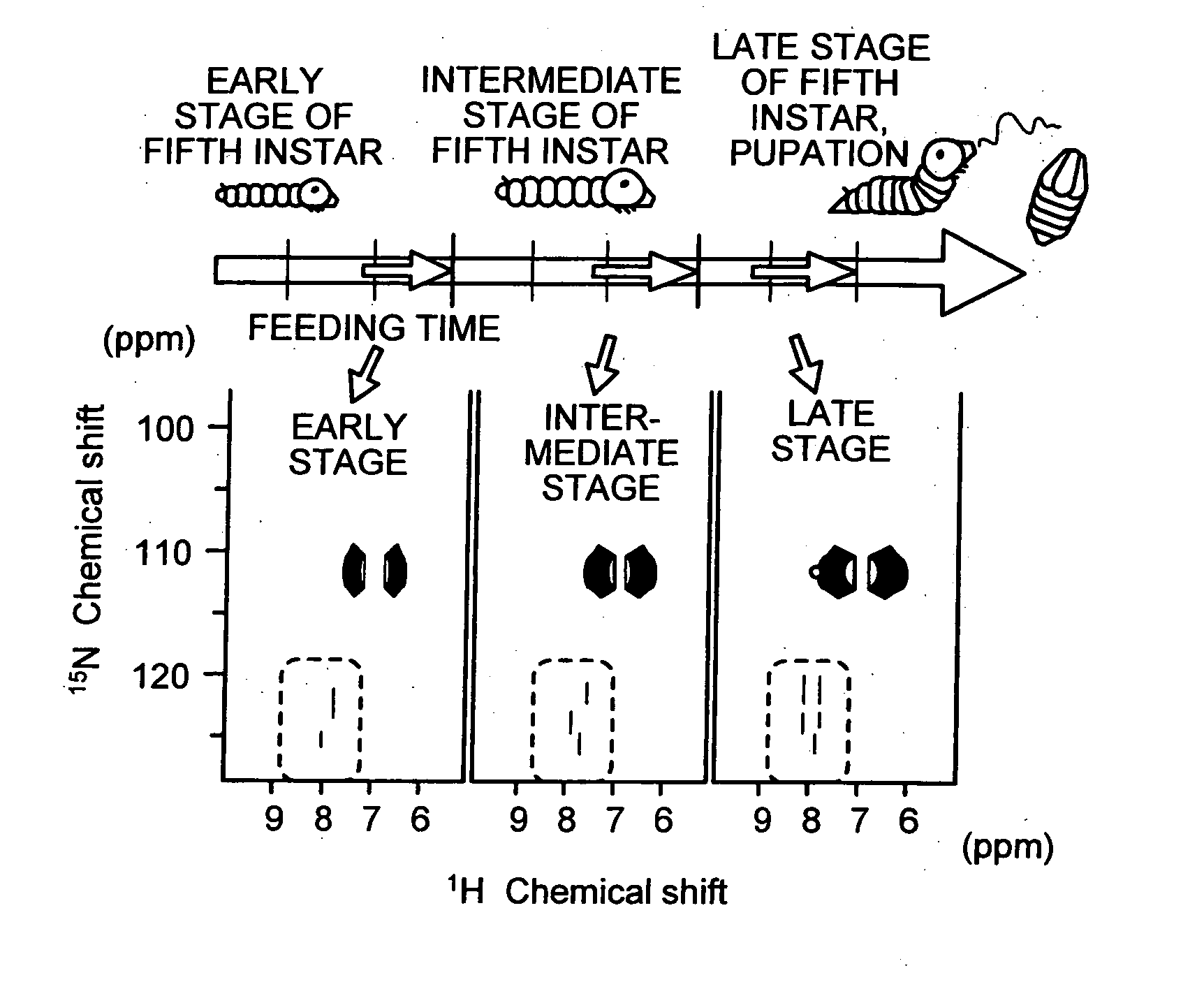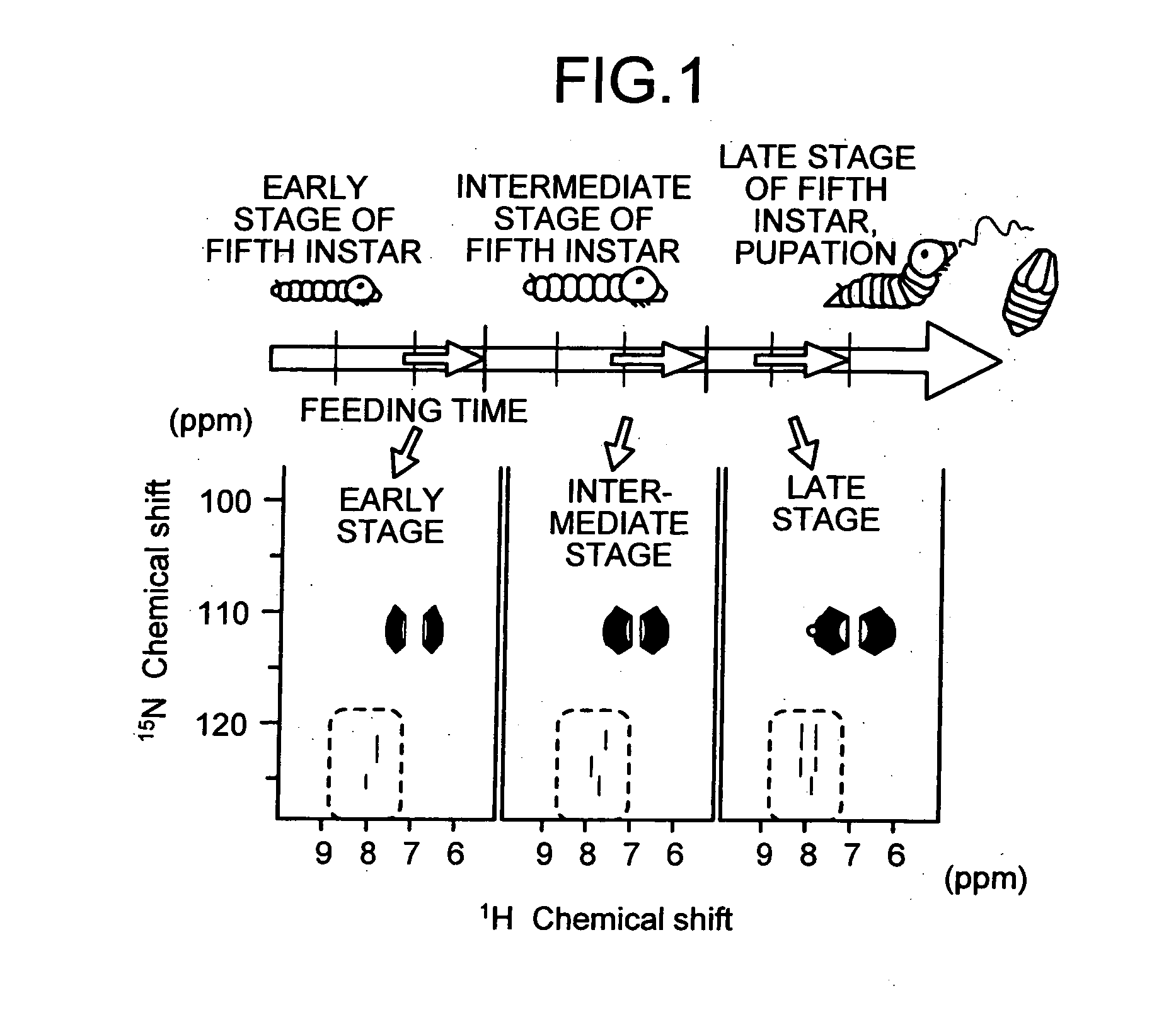Method of analyzing metabolism for animal, method of producing labeled animals, labeled animals and method of measuring NMR for animals
a technology of metabolic analysis and labeling, applied in the field of analyzing metabolic metabolism for animals, can solve the problems of inability to quantitatively analyze mixed samples, lack of development of a methodology enabling, and theoretically impossible non-invasive measuremen
- Summary
- Abstract
- Description
- Claims
- Application Information
AI Technical Summary
Benefits of technology
Problems solved by technology
Method used
Image
Examples
example 1
Production of Labeled Animals (Silkworms)
(1) Production of a Labeled Plant (Arabidopsis thaliana)
[0043] A labeled plant uniformly labeled with a stable isotope was prepared for Arabidopsis thaliana. An ethylene-insensitive mutant strain ein2-5 was used for a label for Arabidopsis thaliana.
[0044] The mutant strain ein2-5 of Arabidopsis thaliana, variety Columbia was seeded in a plant bed that includes vermiculite and perlite (50% each (volume / volume)), and was maintained at 4° C. for 3 days to 4 days to promote germination. Germinating seedlings of the mutant strain ein2-5 were raised at 22° C. to 23° C. using a light-dark cycle of 16 hours of daylight and 8 hours of night. During the course of development, nutrient salts of the composition indicated below (all concentrations are final concentrations) were provided once a week.
KNO35millimoles (mM)KPO3 (pH 5.5)2.5mMMgSO42mMCaCl22mMFe EDTA50micromoles (μM)H3BO370μMMnCl214μMCuSO40.5μMZnSO41μMNaMoO40.2μMNaCl10μMCoCl210nanomoles (nM...
example 2
[0050] Each of silkworms at an early stage, an intermediate stage, and a final stage of the fifth instar were labeled by feeding a labeled food at different feeding times and time periods. The NMR measurement was performed on tissues extracted from each of the silkworms labeled to confirm a condition that resulted in the highest labeling rate.
[0051] The silkworms labeled were dissected after anesthetizing with ice to extract plasma lymph, fat bodies, silk glands and Malpighian tubules. Each of the tissues extracted were frozen with liquid nitrogen and crushed, and then dissolved in dimethyl sulfoxide (DMSO) and transferrin receptor (TFR). Body fluid was not removed and allowed to remain in the tissues this time. Insoluble matter was removed by centrifugation, and supernatant was used as the NMR measurement sample.
[0052] Multi-dimensional NMR measurements were performed on the NMR measurement samples obtained using a Bruker 500 MHz NMR spectrometer and trinuclear probe equipped wit...
example 3
[0054] A 15N-HSQC spectrum of each of silk glands, plasma lymph, and fat bodies of silkworms labeled with 15N were measured. The method for preparing the NMR measurement samples and the measurement conditions were the same as in those used in Example 2.
[0055] The 15N-HSQC spectrum of each of silk glands, plasma lymph, and fat bodies of the silkworms labeled with 15N is shown in FIG. 2. In animal tissue, each tissue has distinct compositions of compounds, and the NMR spectrum shows such distinction very clearly. For example, fibroin protein is present in an overwhelmingly large amount in silk glands, and a signal of the NH derived from peptide bonds of a main peptide chain can be observed at around 8 parts per million (ppm). On the other hand, side chain amide signals of Gln and Asn, which characteristically serve as nitrogen supply sources of larvae, can be clearly observed in the plasma lymph. However, in a fat body tissue, lipids, cholesterol, and phospholipids, which are charact...
PUM
| Property | Measurement | Unit |
|---|---|---|
| natural abundance ratio | aaaaa | aaaaa |
| natural abundance ratio | aaaaa | aaaaa |
| natural abundance ratio | aaaaa | aaaaa |
Abstract
Description
Claims
Application Information
 Login to View More
Login to View More - R&D
- Intellectual Property
- Life Sciences
- Materials
- Tech Scout
- Unparalleled Data Quality
- Higher Quality Content
- 60% Fewer Hallucinations
Browse by: Latest US Patents, China's latest patents, Technical Efficacy Thesaurus, Application Domain, Technology Topic, Popular Technical Reports.
© 2025 PatSnap. All rights reserved.Legal|Privacy policy|Modern Slavery Act Transparency Statement|Sitemap|About US| Contact US: help@patsnap.com



